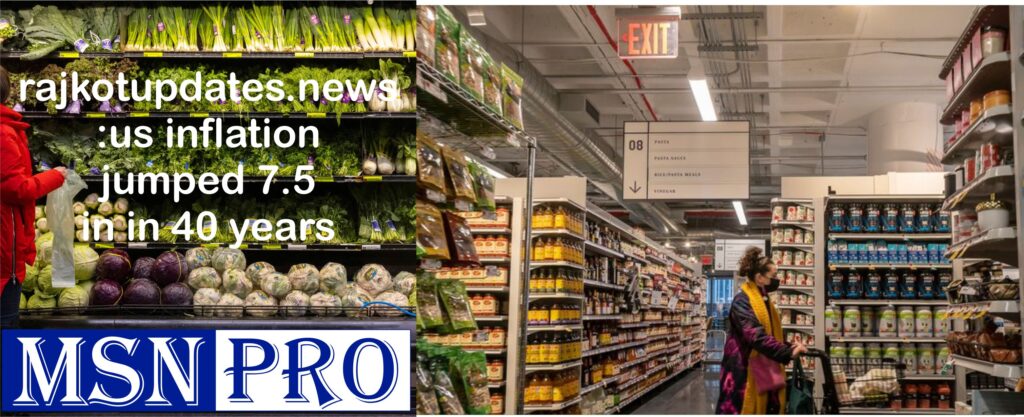Introduction:
The Title, “US Inflation Jumped 7.5% In 40 Years,” From A Recent News Article Draws Attention To An Important Development In US Economic History. This Tutorial Offers A Thorough Explanation Of The Inflation Rate, Including What It Means, Why It Occurs, How It Affects The Economy, And What Businesses And Individuals Can Do About It.
1. Understanding Inflation:
What Is Inflation?
• Definition: The Rate Of General Price Increases For Goods And Services That Reduces Buying Power Is Known As Inflation.
• Measuring: The Producer Price Index (PPI) Or The Consumer Price Index (CPI) Are Commonly Used.
Historical Background:
• Historical Rates: Over The Past 40 Years, A Variety Of Economic Policies And World Events Have Had A Significant Impact On Inflation Rates, Which Have Changed Greatly.
• Comparative Analysis: Examining Historical Inflation Rates Sheds Light On The Importance Of The Current Surge.
2. The Present Increase In Inflation:
How Does An Increase Of 7.5% Signify?
• Significance: With An Inflation Rate Of 7.5%, Which Is The Highest In Forty Years, Prices Have Increased Significantly In A Number Of Sectors.
• Impact: The Cost Of Housing, Electricity, And Consumer Products Are All Impacted By This Rate.
Why There Was A Spike:
• Disruptions To The Global Supply Chain: Prolonged Problems With The Global Supply Chain Have Raised Prices And Caused Shortages.
• Impact Of The Epidemic: The Global Economic Disruption Caused By The COVID-19 Epidemic Exacerbated Inflationary Pressures.
• Monetary Policy: The Actions Of Central Banks, Such As Their Low Interest Rates And Stimulus Packages, Have Been Influential.
3. The Economy’s Impact:
Effect On Consumers:
• Increasing Costs: As The Cost Of Necessities Rises, Consumers’ Disposable Income Declines.
• Purchasing Power: When Money Loses Value, It Becomes More Expensive To Live At The Same Level Of Comfort.
Effect On Business:
• Expenses: Businesses Must Pay More For Transportation And Raw Supplies, Which May Result In Higher Prices For Customers.
• Profit Margins: If Businesses Are Unable To Pass On Rising Expenses To Customers, Their Profit Margins May Decrease.
Markets For Financials:
• Stock Market: As Investors Respond To Shifting Economic Conditions, Inflation May Cause Market Volatility.
• Interest Rates: In Order To Fight Inflation, Central Banks May Raise Interest Rates, Which May Impact The Cost Of Borrowing.
4. Reaction Plans:
Regarding Individuals:
• Budgeting: Making Necessary Expense Adjustments And Setting Priorities For Spending.
• Investing: Taking Into Account Holdings In Commodities Or Real Estate, Two Types Of Assets That Often Do Well During Inflation.
• Savings: Look For Investment Opportunities Or Savings Accounts That Yield Returns Higher Than The Rate Of Inflation.
For Companies:
• Cost Management: Putting Cost-Control Measures In Place, Like Streamlining Supply Chains And Increasing Productivity.
• Pricing Strategies: Keeping Prices Competitive By Modifying Them To Account For Rising Costs.
• Financial Planning: Adapting Budgets To Reflect Rising Expenses And Prospective Rises In Interest Rates.
5. Central Bank And Governmental Actions:
The Monetary Policy:
• Interest Rates: In Order To Combat Inflation, Central Banks May Raise Interest Rates, Which Would Raise The Cost Of Borrowing.
• Reducing:The Money Supply In Order To Lessen Inflationary Pressures Is Known As Quantitative Tightening.
Budgetary Policy:
• Government Expenditure: Modifying Government Expenditure To Regulate Inflation And Oversee Economic Growth.
• Taxation: Putting In Place Tax Laws That Can Aid In Reducing Inflation.
6. Long-Term Consequences:
Economic Development:
• Stability: Economic Instability Brought On By High Inflation Might Harm Long-Term Growth Prospects.
• Investment: A Sustained Rate Of Inflation May Discourage Investment, Which Would Hinder Economic Growth.
Effect On Society:
• Income Inequality: Lower-Income People May Be Disproportionately Affected By Inflation, Which Will Exacerbate The Income Difference.
• Standard Of Living: If Wages Do Not Increase In Line With Growing Prices, Long-Term Inflation May Weaken The Standard Of Living.
7. Verdict:
The Recent Increase Of US Inflation To 7.5% Over The Course Of 40 Years Is A Noteworthy Development With Broad Economic Ramifications. It Is Essential For People, Companies, And Politicians To Comprehend Its Causes, Impacts, And Mitigation Solutions. It Is Possible To Manage The Difficulties Presented By Growing Inflation And Preserve Economic Stability By Remaining Knowledgeable And Proactive.

